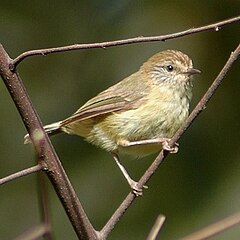Acanthiza
Acanthiza – rodzaj ptaków z podrodziny buszówek (Acanthizinae) w obrębie rodziny buszówkowatych (Acanthizidae).
| Acanthiza[1] | |||
| Vigors & Horsfield, 1827[2] | |||
 Przedstawiciel rodzaju – buszówka żółtobrzucha (A. nana) | |||
| Systematyka | |||
| Domena | |||
|---|---|---|---|
| Królestwo | |||
| Typ | |||
| Podtyp | |||
| Gromada | |||
| Podgromada | |||
| Infragromada | |||
| Rząd | |||
| Podrząd | |||
| Rodzina | |||
| Podrodzina | |||
| Rodzaj |
Acanthiza | ||
| Typ nomenklatoryczny | |||
|
Motacilla pusilla Shaw, 1790 | |||
| Synonimy | |||
|
| |||
| Gatunki | |||
| |||
Zasięg występowania
edytujRodzaj obejmuje gatunki występujące w Australii, na Nowej Gwinei i Tasmanii[8].
Morfologia
edytujDługość ciała 8–12 cm; masa ciała 6–9 g[9].
Systematyka
edytujRodzaj zdefiniowali w 1827 roku irlandzki zoolog Nicholas Aylward Vigors i amerykański przyrodnik Thomas Horsfield na łamach Transactions of the Linnean Society of London[2]. Jako gatunek typowy wyznaczyli buszówkę brązową (A. pusilla).
Etymologia
edytuj- Acanthiza (Acanthisa, Ancathiza): gr. ακανθεων akantheōn „cierniste zarośle”, od ακανθα akantha „cierń”, od ακη akē „punkt”; ζαω zaō „zamieszkiwać, żyć”, od ζω zō „żyć”[10].
- Geobasileus: γεω- geō- „ziemny-”, od γη gē „ziemia”; βασιλευς basileus „mysikrólik”[11]. Gatunek typowy: Saxicola chrysorrhoa Quoy & Gaimard, 1830.
- Milligania: Alexander William Milligan (1858–1921), australijski ornitolog, jeden z założycieli RAOU[12]. Gatunek typowy: Acanthiza robustirostris Milligan, 1903.
- Subacanthiza: łac. sub „w pobliżu, blisko”; rodzaj Acanthiza Vigors & Horsfield, 1827[13]. Gatunek typowy: Acanthiza lineata Gould, 1838.
Podział systematyczny
edytujDo rodzaju należą następujące gatunki[14]:
- Acanthiza chrysorrhoa (Quoy & Gaimard, 1830) – buszówka żółtorzytna
- Acanthiza cinerea (Salvadori, 1876) – buszówka szara
- Acanthiza murina (De Vis, 1897) – buszówka mysia
- Acanthiza nana Vigors & Horsfield, 1827 – buszówka żółtobrzucha
- Acanthiza lineata Gould, 1838 – buszówka kreskowana
- Acanthiza apicalis Gould, 1847 – buszówka szerokosterna
- Acanthiza ewingii Gould, 1844 – buszówka rdzawoczelna
- Acanthiza pusilla (Shaw, 1790) – buszówka brązowa
- Acanthiza katherina De Vis, 1905 – buszówka jasnooka
- Acanthiza robustirostris Milligan, 1903 – buszówka śniada
- Acanthiza iredalei Mathews, 1911 – buszówka mała
- Acanthiza uropygialis Gould, 1838 – buszówka rudorzytna
- Acanthiza reguloides Vigors & Horsfield, 1827 – buszówka zmienna
- Acanthiza inornata Gould, 1841 – buszówka uboga
Uwagi
edytujPrzypisy
edytuj- ↑ Acanthiza, [w:] Integrated Taxonomic Information System (ang.).
- ↑ a b G.A. Vigors & T. Horsfield. A Description of the Australian Birds in the Collection of the Linnean Society; with an Attempt at arranging them according to their natural Affinities. „Transactions of the Linnean Society of London”. 15 (1), s. 224, 1827. (ang.).
- ↑ R.-P. Lesson: Compléments de Buffon. Paris: P. Pourrat Frères, 1837, s. 120. (fr.).
- ↑ J. Cabanis: Museum Heineanum: Verzeichniss der ornithologischen Sammlung des Oberamtmann Ferdinand Heine, auf Gut St. Burchard vor Halberstadt. Cz. 1: Singvögel. Halberstadt: In Commission bei R. Frantz, 1850–1851, s. 32. (niem.).
- ↑ Ch.W. De Vis. Ornithological. „Annals of the Queensland Museum”. 6, s. 43, 1891. (ang.).
- ↑ G.M. Mathews. New generic names for Australian birds. „Austral Avian Record”. 1 (5), s. 112, 1912–1913. (ang.).
- ↑ G.M. Mathews: The Birds of Australia. Cz. 9. London: H.F. & G. Witherby, 1922, s. 449. (ang.).
- ↑ F. Gill, D. Donsker & P. Rasmussen (redaktorzy), Bristlebirds, pardalotes, Australasian warblers [online], IOC World Bird List (v13.1) [dostęp 2023-05-31] (ang.).
- ↑ D.W. Winkler, S.M. Billerman & I.J. Lovette, Thornbills and Allies (Acanthizidae), version 1.0, [w:] S.M. Billerman, B.K. Keeney, P.G. Rodewald & T.S. Schulenberg (redaktorzy), Birds of the World, Cornell Lab of Ornithology, Ithaca, NY 2021, [1], DOI: 10.2173/bow.acanth2.01 [dostęp 2023-05-31] (ang.).
- ↑ The Key to Scientific Names ↓, Acanthiza [dostęp 2023-05-31].
- ↑ The Key to Scientific Names ↓, Geobasileus [dostęp 2023-05-31].
- ↑ The Key to Scientific Names ↓, Milligania [dostęp 2023-05-31].
- ↑ The Key to Scientific Names ↓, Subacanthiza [dostęp 2023-05-31].
- ↑ Systematyka i nazwy polskie za: P. Mielczarek & M. Kuziemko, Podrodzina: Acanthizinae Bonaparte, 1854 – buszówki (wersja: 2021-10-03), [w:] Kompletna lista ptaków świata [online], Instytut Nauk o Środowisku Uniwersytetu Jagiellońskiego [dostęp 2023-05-31].
Bibliografia
edytuj- The Key to Scientific Names, J.A. Jobling (red.), [w:] Birds of the World, S.M. Billerman et al. (red.), Cornell Lab of Ornithology, Ithaca (ang.).